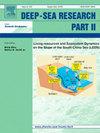Ecological coastal design: Evaluating microtexture and groove manipulations in the Persian Gulf and Gulf of Oman
IF 3
3区 地球科学
Q2 OCEANOGRAPHY
Deep-sea Research Part Ii-topical Studies in Oceanography
Pub Date : 2025-04-07
DOI:10.1016/j.dsr2.2025.105482
引用次数: 0
Abstract
The exponential growth of the human population, particularly in coastal regions, has led to the widespread construction of coastal infrastructures such as breakwaters, seawalls, and revetments. These structures differ considerably from natural habitats in their physical characteristics, chemical composition, and ecological connectivity. In the present study, using eco-engineering, various concrete panels with distinct surface textures and designs (panel group) as well as different manipulations (manipulation group) were implemented in three coastal locations in the Persian Gulf and Gulf of Oman. Consequently, colonization patterns of marine organisms were monitored monthly over a one-year period. The results indicated a significant effect of location on both species richness and abundance within the panel group. Moreover, the type of manipulation had a significant impact on species abundance. Panels featuring microtexture displayed the greatest species richness, followed by panels that included shells. Multivariate analyses revealed significant differences in community structure across diverse eco-engineered structures. The study concluded that ecological engineering techniques, such as incorporating microtexture or millimeter-scaled manipulations, can significantly impact community structure, species richness, and abundance in coastal habitats. The design of eco-engineered structures should be tailored to the prevailing environmental conditions to effectively enhance coastal habitats and promote biodiversity.
生态海岸设计:评估波斯湾和阿曼湾的微纹理和沟槽操作
人口的指数增长,特别是在沿海地区,导致了沿海基础设施的广泛建设,如防波堤、海堤和护岸。这些结构在物理特征、化学成分和生态连通性方面与自然栖息地有很大不同。在本研究中,利用生态工程技术,在波斯湾和阿曼湾的三个沿海地区实施了具有不同表面纹理和设计的各种混凝土面板(面板组)以及不同的操作(操作组)。因此,在一年的时间里,每月监测海洋生物的定植模式。结果表明,地理位置对群落内物种丰富度和丰度均有显著影响。此外,操作类型对物种丰度有显著影响。微纹理板的物种丰富度最高,含壳板次之。多变量分析表明,不同生态工程结构的群落结构存在显著差异。该研究得出结论,生态工程技术,如结合微纹理或毫米尺度的操作,可以显著影响沿海栖息地的群落结构、物种丰富度和丰度。生态工程构筑物的设计应适应当前的环境条件,以有效地改善沿海生境,促进生物多样性。
本文章由计算机程序翻译,如有差异,请以英文原文为准。
求助全文
约1分钟内获得全文
求助全文
来源期刊
CiteScore
6.40
自引率
16.70%
发文量
115
审稿时长
3 months
期刊介绍:
Deep-Sea Research Part II: Topical Studies in Oceanography publishes topical issues from the many international and interdisciplinary projects which are undertaken in oceanography. Besides these special issues from projects, the journal publishes collections of papers presented at conferences. The special issues regularly have electronic annexes of non-text material (numerical data, images, images, video, etc.) which are published with the special issues in ScienceDirect. Deep-Sea Research Part II was split off as a separate journal devoted to topical issues in 1993. Its companion journal Deep-Sea Research Part I: Oceanographic Research Papers, publishes the regular research papers in this area.

 求助内容:
求助内容: 应助结果提醒方式:
应助结果提醒方式:


